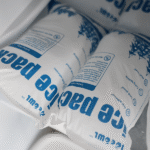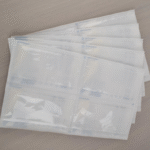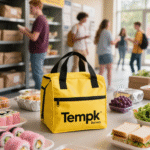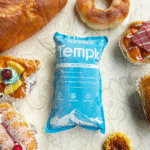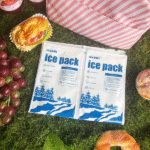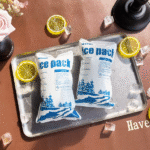Elemen Interaktif: Provide a Packaging Selection Tool that asks users about product type, kisaran suhu yang diinginkan, durasi transit dan tujuan keberlanjutan untuk merekomendasikan pengemasan yang sesuai (MISALNYA., reusable vs disposable, PCM vs es kering). Termasuk a Self Assessment Quiz on sustainable packaging readiness and a clear Call To Action (CTA) prompting users to request a free packaging consultation.
Solusi pengemasan rantai dingin are specialized containers and materials that protect temperature sensitive goods—from vaccines to seafood—during shipping and storage. Sampai 2024 the global market was valued at roughly USD 34.28 miliar dan diperkirakan akan tumbuh menjadi USD 89.84 miliar oleh 2034, illustrating rising demand for robust packaging. You need packaging that not only maintains proper temperatures but also aligns with sustainability goals and emerging regulations. This guide explains market drivers, explores materials like expanded polystyrene (EPS), panel terisolasi vakum (VIP) dan bahan perubahan fase (PCMS), and shows how innovation and consumer expectations are reshaping the way you ship perishable products.
What is cold chain packaging and why do you need it? Understand the basics, including temperature ranges and materials.
How large is the market and where is it growing fastest? Get updated numbers, regional insights and key segments.
Which materials and technologies should you consider? Explore EPS, Pur, VIP, PCMS, gel packs and smart labels.
How can sustainable packaging benefit your business? Learn about consumer preferences, regulations and reusable solutions.
What innovations are shaping packaging in 2025 dan seterusnya? Discover AI, Sensor IoT, blockchain, and advanced insulation.
What Is Cold Chain Packaging and Why Do You Need It?
A clear definition
Cold chain packaging refers to specialized insulated containers and materials designed to maintain safe temperatures for perishable goods during transport and storage. It includes insulated boxes, pallet shippers, Paket gel, foam bricks and phase change materials. These packages protect items like food, vaksin, pharmaceuticals and biologics from heat or freezing, ensuring quality and safety. A proper packaging solution is essential because even a slight temperature excursion can compromise product integrity.
Mengapa itu penting bagi Anda
Without adequate packaging, your frozen seafood could thaw or your vaccines lose potency. Cold chain packaging maintains specific ranges—frozen (–20 °C hingga –80 °C), didinginkan (2 ° C ke 8 ° C.) or controlled room temperature (15 ° C ke 25 ° C.). Materials such as polystyrene foam, busa poliuretan, vacuum insulated panels and seaweed based bioplastics minimize heat transfer. Gel packs or PCMs absorb and release heat to stabilize temperature. By choosing the right solution, you protect product quality, comply with regulations and reduce waste.
Packaging types and temperature zones
| Jenis pengemasan | Kisaran Suhu Khas | Kasus Penggunaan Terbaik | Apa artinya ini bagi Anda |
| EPS or PUR foam containers | 2 °C–8 °C | Produk segar, susu, vaksin | Ringan, low cost and widely available; good for short shipments. |
| Panel terisolasi vakum (VIP) | –20 °C hingga –80 °C | Daging beku, Biologi | Provide superior insulation with thin walls; ideal for long trips but costlier. |
| Gel packs and foam bricks | Maintain ambient or refrigerated conditions | Kit makan, Farmasi | Provide flexible cooling; can be reusable and combined with insulation. |
| Bahan perubahan fase (PCM) paket | 2 °C–8 °C or –20 °C to –25 °C | Vaksin, Biologi, reagen | Reusable packs that absorb and release heat at specific points; tidak berbahaya. |
| Kemasan es kering | Below –70 °C | Biologi yang sangat beku, sel beku | Single use packaging providing ultra cold temperatures but subject to hazardous materials regulations. |
Tip dan saran praktis
Match your product’s temperature range to the right packaging: Use PCM packs for biologics requiring 2–8 °C or –20 °C, and dry ice for ultra cold shipments like CRISPR materials.
Pertimbangkan durasi pengiriman: Gel packs and PCM work well for shipments under 72 jam. Untuk perjalanan lebih jauh 96 hours in deep freeze, dry ice or hybrid systems may be needed.
Plan for reuse: Choose durable PCM packs or insulated containers to reduce waste and cut long term costs.
Contoh kasus: A biotech firm shipping vaccines to rural clinics adopted PCM packs inside VIP containers. The solution maintained 2–8 °C for 72 hours without active refrigeration, cutting dry ice use and hazardous handling. Sebagai akibat, product losses dropped by 20%, and shipping costs fell due to reusable packs.
How Large Is the Cold Chain Packaging Market and Where Is It Growing?
Market size and growth
The cold chain packaging market is booming. Towardspackaging reports that the industry was valued at USD 34.28 miliar masuk 2024 and is expected to mencapai Rp 89.84 miliar oleh 2034, tumbuh di a CAGR dari 11.3 %. The report indicates that North America dominated the market in 2024, while Asia Pacific is poised for significant growth. Polystyrene yang diperluas (EPS) led the material segment, insulated containers led by product type, dan ikan, meat and seafood dominated the end use segment.
Di Amerika Serikat, the market size was USD 7.97 miliar masuk 2024, and it is forecast to grow at a 15.6 % CAGR dari 2025 ke 2030. Insulated containers and boxes held 55.2 % of revenue share in 2024 due to rising demand for temperature sensitive products. Insulating materials represented 58.1 % of revenue share. Cold packs are expected to grow at 17.6 % CAGR driven by meal kit delivery and online grocery.
Drivers and regional dynamics
Market expansion is fueled by increasing demand for frozen food, Farmasi, and e commerce grocery deliveries. North America’s dominance stems from strong pharmaceutical shipments and advanced distribution networks, whereas Asia Pacific’s growth is powered by rising incomes and biopharma exports. Europe is investing in carbon neutral packaging to comply with EU sustainability goals. Sementara itu, Latin America and Middle East & Africa are ramping up cold chain logistics to support food exports and high value pharmaceuticals. In many emerging economies, kesenjangan infrastruktur, high energy costs and regulatory compliance remain challenges.
Trends by segment
AS. market reveals interesting sub segment trends:
Product types: Insulated containers and boxes hold the largest share (55.2 %). Cold packs and gel bricks are gaining popularity due to meal kit deliveries and home grocery shipments.
Material types: Insulating materials like polyurethane foam and VIPs capture 58.1 % of revenue thanks to high thermal performance. Reusable refrigerants such as PCMs and gel packs are rising as sustainable alternatives.
End use industries: Fish, daging & seafood dominate due to strict temperature control requirements. Pharmaceuticals and biologics account for a large share in Europe and North America.
Apa artinya bagimu
The numbers show that packaging is no longer an afterthought; it’s a strategic investment. With global food and pharmaceutical trade expanding, companies need packaging that can scale across regions and adhere to local regulations. Understanding which segments are growing fastest helps you allocate resources effectively. Misalnya, if you serve the meal kit market, invest in lightweight cold packs; if you ship biologics, consider VIPs and PCMs.
What Materials and Technologies Power Cold Chain Packaging Solutions?
Traditional materials: EPS, PUR and VIPs
Polystyrene yang diperluas (EPS) and polyurethane rigid foam (Pur) are the workhorses of cold chain packaging. They provide lightweight, cost effective insulation and dominated the material share in 2024. EPS is often used in fish and seafood shipments due to its low cost and effective insulation. PUR foam offers similar benefits but can be more durable. Panel terisolasi vakum (VIP) deliver superior insulation with thin walls, making them ideal for high value pharmaceuticals and biologics. Namun, VIPs are more expensive and require careful handling.
Bahan perubahan fase (PCMS) vs dry ice
PCM menyerap dan melepaskan panas pada suhu tertentu, maintaining stable ranges (such as 2–8 °C or –20 °C). Mereka dapat digunakan kembali, non hazardous and simplify compliance. Es kering, karbon dioksida padat, sublimates at –78.5 °C to provide ultra cold conditions for deep frozen biologics. Dry ice is inexpensive per shipment but must be replenished and handled according to hazardous materials regulations. PCM systems require higher upfront investment but offer multiple reuse cycles, mengurangi limbah dan biaya jangka panjang.
Smart packaging and IoT integration
Technologies such as time temperature indicators, RFID tags and IoT sensors are increasingly embedded in packaging to monitor conditions in real time. Smart packaging enables you and your customers to check temperature history via QR codes, ensures compliance with FDA and WHO guidelines, and triggers alerts if a package deviates from its target range. Analisis prediktif can forecast equipment failures and suggest alternative routes. AI powered computer vision inspects packaging for leaks or damage, and drones assess warehouse conditions. Smart packaging not only improves safety but also reduces manual checks and accelerates decision making.
Emerging materials and sustainable options
Sustainability is prompting a shift from fossil fuel derived plastics to biodegradable and recyclable alternatives. Materials like seaweed based bioplastics, corn starch foam and wood fiber provide insulation while reducing environmental impact. Seaweed derived packaging is gaining traction because it forms films that are edible or dissolve in water, leaving no microplastics. Cardboard and recycled paper are used for outer cartons and provide structural support. Some companies are experimenting with hybrid solutions combining recycled PET with VIPs for improved thermal performance and recyclability. Drain safe refrigerant gels avoid harmful chemicals and can be disposed of safely.
Choosing the right solution
| Material or Technology | Karakteristik Utama | Suitable Use Cases | Keuntungan |
| EPS/PUR | Rigid foam panels; Biaya rendah; moderate insulation | Short distance food shipments, kit makan | Terjangkau, Tersedia secara luas, easy to recycle (with infrastructure). |
| VIP | Vacuum panels with thin insulation | Farmasi, Biologi, barang bernilai tinggi | Excellent thermal performance, reduces size and weight. |
| Paket PCM | Reusable packs that melt/solidify at set temperatures | Vaksin, clinical trial kits | Maintain specific ranges; tidak berbahaya; multiple reuse cycles. |
| Es kering | Co₂ solid; menyublim pada –78,5 °C | Gene therapies, sel beku | Provides ultra cold environment; Tersedia secara luas. |
| Seaweed based foam | Dapat terurai secara hayati, kompos | Eco friendly meal kits, hidangan laut | Reduces plastic use; dissolves in water; consumer friendly appeal. |
| Sensor pintar & Label | RFID, time temperature indicators, Kode QR | All high value shipments | Pemantauan waktu nyata, blockchain integration, predictive analytics. |
Best practices and recommendations
Balance performance and cost: Use foam or corrugated cardboard for low risk shipments; invest in VIPs and PCMs for high value pharmaceuticals and extended transit times.
Integrate monitoring: Add sensors or smart labels to any cold chain package. Real time data ensures early detection of temperature excursions and regulatory compliance.
Gunakan kemasan yang dapat digunakan kembali: Durable containers and PCM packs reduce long term costs and help meet sustainability goals.
Evaluate local recycling infrastructure: Select materials that can actually be recycled in your recipient’s region; consider take back programs if infrastructure is lacking.
Contoh kasus: A meal kit company switched from EPS to recyclable paper and starch based foam packaging. The new solution maintained refrigerated temperatures for 24 hours and reduced packaging volume by 30 %. Customer satisfaction improved, and the company saved on waste disposal fees while aligning with sustainability pledges.
How Can Sustainable Packaging Benefit Your Business?
Consumer preferences and regulatory pressures
Sustainable cold chain packaging is no longer a nice to have—it’s a must. According to Cold Chain Technologies, 79 % of consumers change purchase preferences based on social or environmental impact; 67 % say they will be more cautious about resource scarcity due to the COVID 19 crisis. Governments are also raising the bar: EU member states must pay €0.80 per kilogram of non recycled plastic packaging, and the UK imposes a tax on packaging with less than 30 % konten daur ulang. The European Packaging and Packaging Waste Directive mandates that 65 % of all packaging waste be recycled by 2025, with higher targets by 2030. Di AS, extended producer responsibility (EPR) laws in states like California and Maine require companies to finance recycling programs, pushing adoption of recyclable and reusable solutions.
Types of sustainable packaging and their benefits
Sustainable cold chain solutions fall into several categories:
Recyclable materials: Kardus, polyethylene and paper are increasingly used for insulated liners and outer boxes. These materials can be processed and reused, Mengurangi limbah TPA.
Kemasan yang dapat digunakan kembali: Durable gel packs, insulated containers and pallet shippers can be reused multiple times, lowering per shipment cost and waste. The reusable cold chain packaging market is forecast to grow from USD 4.97 miliar masuk 2025 ke USD 9.13 miliar oleh 2034.
Bahan biodegradable: Corn starch foam, wood fiber, seaweed bioplastics and cotton insulation decompose naturally and reduce environmental impact.
Eco friendly refrigerants: Drain safe gel packs and biodegradable gels replace harmful refrigerants and can be safely disposed of.
Innovative insulation materials: Recycling post industrial cardboard fibers into high performance insulation reduces waste and offers excellent thermal performance.
Data supporting sustainability
Taylor’s blog reports that 43 % of consumers consider packaging’s environmental impact ketika membuat keputusan pembelian. The reusable packaging market for beauty and personal care products grew 65 % dari 2020 ke 2021. 74 % of Americans are interested in buying products in refillable packaging, showing mainstream acceptance of reuse models. Supply of recycled PET has grown tentang 4 % setiap tahun over the past decade, reflecting increased demand for recycled materials.
Challenges and how to overcome them
Meskipun terdapat manfaat-manfaat ini, sustainable packaging adoption faces hurdles:
Biaya: Designing, sourcing and producing sustainable packaging can be more expensive than conventional EPS. Namun, bulk purchasing, supplier partnerships and lifecycle cost analysis often reveal long term savings.
Change management: Switching materials requires organisation wide commitment and process adjustments. Pilot projects and employee training can ease the transition.
Trust: Stakeholders may doubt that new materials offer adequate protection. Validate solutions through thermal testing, certifications and case studies.
Infrastruktur: Recycling or composting infrastructure may be lacking. Consider take back schemes, reusable packaging programs or local partnerships to ensure end of life recovery.
Tersedianya: Sustainable materials may be scarce, causing supply chain issues. Diversify suppliers and maintain buffer stock to reduce risk.
Contoh kasus: A pharmaceutical distributor replaced single use EPS boxes with a pool of reusable VIP shippers and PCM packs. Although initial costs were higher, the company reduced packaging waste by 70 %, saved money over three years and met new EPR requirements. Customers appreciated the sustainability effort, boosting brand reputation.
What Innovations Are Shaping Cold Chain Packaging in 2025 dan seterusnya?
Ai, IoT and data analytics
Artificial intelligence and IoT sensors are transforming packaging. Smart labels record temperature history and scan via smartphone apps. AI powered platforms detect patterns in sensor data and predict when a storage unit might fail. Integration with blockchain provides immutable temperature records and automates payment when shipments meet specified conditions. Companies like Flexport and Shipwell use AI to analyse weather, traffic and facility availability to optimise routes and reduce fuel consumption.
Reusable and modular systems
Reusable packaging is gaining traction. Towards Packaging predicts the reusable cold chain packaging market will grow to USD 9.13 miliar oleh 2034. Modular systems with stackable components allow carriers to adjust capacity and reduce empty space. Reuse programmes often include digital tracking to ensure returns and sanitation. Companies are exploring deposit programmes where customers pay a fee refunded upon returning packaging.
Insulasi tingkat lanjut dan bahan ramah lingkungan
New insulation materials include seaweed based bioplastics Dan recycled foam that deliver comparable thermal performance to EPS while reducing environmental impact. Vacuum insulated panels are becoming thinner and more affordable, making them accessible to smaller shippers. Bahan perubahan fase are being engineered with precise melt points and higher latent heat capacity to extend temperature control without increasing weight. Hybrid packaging combining dry ice and PCMs offers multi temperature compartments for mixed shipments.
Sustainable refrigerants and eco friendly gels
Drain safe gels and biodegradable refrigerants are replacing conventional gel packs, mengurangi dampak lingkungan. Some companies are using PCM based refrigerants derived from vegetable oils or plant extracts. Research is ongoing into natural eutectic solvents that can be tuned to specific temperatures and reused many times.
Blockchain and smart contracts
Blockchain technology ensures data integrity and supports smart contracts for automated compliance and payments. When integrated with IoT sensors, blockchain records every temperature reading in a tamper proof ledger. This transparency builds trust among shippers, carriers and regulators. Smart contracts release payments or insurance coverage only if the shipment stays within specified temperature ranges, reducing disputes and administrative overhead.
The role of regulation and standardisation
Governments and industry groups are developing standards for reusable packaging, sensor calibration and data sharing. Oleh 2025, 74 % data logistik diharapkan terstandarisasi. Such standardisation will enable seamless information exchange between partners and support circular economy initiatives. Regulatory bodies like the FDA, EMA and WHO are updating guidelines for biologics shipping, requiring validated packaging and digital monitoring.
Contoh kasus: A European biotech start up adopted seaweed based insulated pouches with embedded RFID tags. The packaging maintained 2–8 °C for 48 hours and was compostable after use. With blockchain integration, the company provided regulators with verifiable temperature records, accelerating cross border clearance and strengthening its sustainability credentials.
What Are the Challenges and Best Practices for Implementing Cold Chain Packaging Solutions?
Key challenges
Tekanan biaya: Advanced insulation and reusable systems have higher upfront costs. Determine total cost of ownership by considering reuse cycles, waste disposal and compliance fines.
Complexity and training: New materials and technologies require training for packing, monitoring and returning containers. Without proper procedures, employees may misuse components or ignore alerts.
Kepatuhan Pengaturan: Standards vary by country and product category. Packaging must comply with rules like FDA 21 Bagian CFR 11 for electronic records, IATA dangerous goods regulations for dry ice and local recycling laws.
Reverse logistics: Managing the return and sanitation of reusable packaging requires infrastructure and collaboration with carriers and customers. Loss or theft of reusable containers can erode cost savings.
Data security and integration: Sharing sensor data across partners demands secure systems and agreements. Data silos can hinder visibility and response.
Best practices
| Tantangan | Latihan yang Direkomendasikan | How it helps |
| Biaya | Conduct a life cycle cost analysis and negotiate multi year contracts with packaging suppliers | Helps quantify savings from reuse, waste reduction and reduced spoilage. |
| Kompleksitas | Provide hands on training and digital manuals; start with pilot projects | Builds employee confidence and identifies issues before full rollout. |
| Kepatuhan Pengaturan | Stay updated on global and local regulations; partner with packaging vendors who provide validated systems | Reduces risk of fines and product loss; ensures documentation meets audit requirements. |
| Reverse logistics | Set up collection points and track containers with QR codes; design easy to-clean packaging | Improves return rates and ensures sanitation, preserving packaging lifespan. |
| Data security | Use encrypted data transmission and blockchain; establish clear data sharing agreements | Protects sensitive information and builds trust among partners. |
Saran praktis
Mulailah dari yang kecil: Pilot a sustainable packaging solution on a single product line or route before scaling up. Collect data on temperature performance, customer feedback and return logistics.
Engage suppliers early: Work with packaging manufacturers to customise solutions to your products and distribution network. Ask for thermal performance data and sustainability certifications.
Pantau dan sesuaikan: Use IoT sensors to gather real time data on packaging performance and adjust your protocols accordingly. Seiring waktu, you can reduce buffer materials and weight.
Contoh kasus: An e commerce seafood company piloted a returnable insulated box program. They provided customers with prepaid return labels and offered loyalty points for returning boxes. The pilot achieved a 60 % return rate, reduced packaging waste by half and improved customer retention.
2025 Latest Cold Chain Packaging Developments and Trends
Tinjauan Tren
The global cold chain packaging landscape in 2025 is shaped by sustainability, smart technology and evolving regulations. Companies must adapt to stricter recycling targets, consumer demand for eco friendly options and more stringent temperature control rules. Pada saat yang sama, innovations like AI enabled packaging, hybrid refrigerants and blockchain are raising the bar for reliability and efficiency.
Kemajuan terbaru sekilas
Reusable market expansion: The reusable cold chain packaging market is projected to grow from USD 4.97 miliar masuk 2025 ke USD 9.13 miliar oleh 2034. Companies across food and pharma sectors are investing in durable shippers and deposit schemes.
AI driven monitoring: Smart sensors and predictive analytics are becoming standard. Packaging solutions now include integrated data loggers, RFID tags and QR codes to provide real time visibility and support predictive maintenance.
Rise of biodegradable insulation: Materials derived from seaweed, corn starch and wood fibers are being commercialized, offering comparable thermal performance while meeting consumer expectations for plastic free packaging.
Refrigeran hibrida: Companies are combining PCMs with dry ice in modular packages to support mixed temperature ranges within one shipment. Hybrid solutions reduce hazardous shipments and increase flexibility.
Harmonisasi Pengaturan: International organisations like the International Air Transport Association (Iata), International Maritime Organization (IMO) and World Health Organization (SIAPA) are aligning temperature control and documentation standards, simplifying cross border compliance.
Wawasan pasar
Market consolidation is increasing. Major players like Cold Chain Technologies, Sonoco Thermosafe and CSafe are investing in smart packaging and sustainable materials. Partnerships between logistics providers and packaging firms are common as companies look to integrate monitoring and packaging solutions. Venture capital funding is flowing into sustainable packaging startups, particularly those producing biodegradable insulation and smart labels.
Pertanyaan yang sering diajukan
What are phase change materials, and how do they differ from gel packs or dry ice?
Bahan perubahan fase (PCMS) are compounds that store and release heat at specific temperatures, maintaining stable conditions within a package. Berbeda dengan paket gel, which simply hold cold or heat, PCMs undergo a phase transition (solid to liquid or vice versa), absorbing or releasing latent heat to maintain the desired temperature. Es kering memberikan kondisi yang sangat dingin (< –70 °C) by sublimating, but it is single use and regulated as a hazardous material. PCMs are reusable and easier to handle, making them ideal for vaccines and biologics requiring 2–8 °C or –20 °C ranges.
How can I decide between reusable and single use packaging?
Consider shipment frequency, jarak, product value and sustainability goals. Reusable packaging has higher upfront costs but delivers long term savings through multiple cycles. It’s ideal for frequent shipments and established return logistics. Single use packaging may be more practical for one off shipments or destinations lacking return infrastructure.
Are biodegradable materials robust enough for cold chain applications?
Ya, when designed correctly. Biodegradable foams and seaweed based plastics are engineered to provide comparable insulation to EPS while breaking down naturally after use. Namun, you must validate their performance with thermal tests and ensure they fit your product’s weight and size requirements.
Do smart labels and IoT sensors increase packaging costs significantly?
While smart labels add cost, they reduce product loss and compliance issues by providing real time visibility. Many shippers find that the savings from avoiding spoilage and delays outweigh the additional expense. Start with critical shipments and scale gradually.
How do regulations differ for dry ice vs PCM shipments?
Dry ice is classified as a hazardous material and must comply with IATA, Peraturan DOT dan PBB. Shipments require special labeling, ventilation and training. PCM shipments are generally non hazardous but still must meet temperature logging and validation requirements, seperti FDA 21 Bagian CFR 11.
Ringkasan & Rekomendasi
Pasar Pengemasan Rantai Dingin mengalami pertumbuhan yang cepat, projected to rise from USD 34.28 miliar masuk 2024 ke USD 89.84 miliar oleh 2034. Wadah terisolasi, gel packs and advanced materials like VIPs and PCMs are key components of this expansion. Market dynamics vary by region: North America leads due to strong pharmaceutical demand, while Asia Pacific is catching up quickly. Sustainability pressures are reshaping packaging, with consumers and regulators demanding recyclable, reusable and biodegradable solutions. Innovations like AI enabled monitoring, reusable packaging systems and hybrid refrigerants will dominate 2025 dan seterusnya.
Langkah-langkah tindakan:
Assess your product and route requirements to choose appropriate packaging materials and refrigerants. Use decision tools to match temperature range and transit time.
Berinvestasilah dalam kemasan cerdas with sensors and data logging for high value shipments to prevent spoilage and prove compliance.
Transition to sustainable packaging by integrating recyclable or reusable solutions. Evaluate life cycle cost and partner with suppliers offering eco friendly options.
Pilot innovations such as PCM packs and biodegradable foam on select lanes before scaling up; gather data on performance and customer feedback.
Tetap terinformasi tentang peraturan regarding packaging taxes and recycling targets to avoid penalties and meet customer expectations.
Tentang tempk
Pada Tempk, we design and manufacture smart cold chain packaging that keeps your products safe and your sustainability goals on track. Our portfolio includes reusable VIP containers, PCM packs and eco friendly insulated boxes made from recycled materials. We integrate IoT sensors and cloud analytics to provide real time visibility and compliance reporting. With a global network of partners, we deliver customised solutions for food, industri farmasi dan bioteknologi. We’re committed to reducing waste and carbon footprint through innovative design and circular economy practices.
Ready to transform your packaging? Contact Tempk today for a free consultation on tailoring sustainable and reliable cold chain packaging solutions to your needs. Let’s keep your products safe, your customers happy and our planet healthy.

















